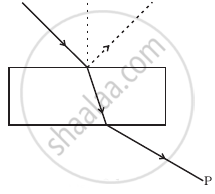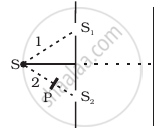Advertisements
Advertisements
प्रश्न
If the critical angle of a medium is sin-1(3/5), find the polarising angle.
उत्तर
Given :
The critical angle is given as
sinθc = 1/n
`therefore theta_c=sin^-1(1/n)` ...(1)
It is given that
`theta_c=sin^-1(3/5)`
`therefore sin^-1(1/n)=sin^-1(3/5)` ...........form (1)
`therefore 1/n=3/5`
`therefore n=5/3`
Now, the polarising angle is given as
`theta_p=tan^-1 n`
`theta_p=tan^(-1)(5/3)`
`theta_p=tan^(-1)(1.667)`
`theta_p=59^@2'`
the polarising angle is `59^@2'`
APPEARS IN
संबंधित प्रश्न
If the polarising angle for a given medium is 60°, then the refractive index of the medium is.................
With the help of neat diagram, explain how non-polar dielectric material is polarised in external electric field of increasing intensity. Define polarisation in dielectrics.
Why does an unpolarised light incident on a polaroid get linearly polarised ?
A beam of unpolarised light is incident on a glass-air interface. Show, using a suitable ray diagram, that light reflected from the interface is totally polarised, when μ = tan iB, where μ is the refractive index of glass with respect to air and iB is the Brewster's angle.
Two polaroids P1 and P2 are placed with their pass axes perpendicular to each other. An unpolarised light of intensity Io is incident on P1. A third polaroid P3 is kept in between P1 and P2 such that its pass axis makes an angle of 45° with that of P1. Determine the intensity of light transmitted through P1, P2 and P3
When a low flying aircraft passes overhead, we sometimes notice a slight shaking of the picture on our TV screen. Suggest a possible explanation.
What is the value of refractive index of a medium of polarising angle 60°?
What does a polaroid consist of? How does it produce a linearly polarised light?
Unpolarised light is incident on a polaroid. How would the intensity of transmitted light change when the polaroid is rotated?
A beam of light is incident at the polarizing angle of 35° on a certain glass plate. The refractive index of the glass plate is :
Green light is incident at the polarising angle on a certain transparent medium. The angle of refraction is 30° . Find
(i) polarising angle, and
(ii) refractive index of the medium.
A ray of light is incident on a transparent medium at a polarizing angle. What is the angle between the reflected ray and the refracted ray?
Greenlight is an incident at the polarising angle on a certain transparent medium. The angle of refraction is 30°.
Find
(i) polarising angle, and
(ii) refractive index of the medium.
Light transmitted by Nicol prism is ______.
What is polarisation?
Discuss polarisation by selective absorption.
What is plane polarised light?
What is unpolarised light?
State and obtain Malus’ law.
State Brewster’s law.
What is double refraction?
Mention the types of optically active crystals with example.
Consider a light beam incident from air to a glass slab at Brewster’s angle as shown in figure. A polaroid is placed in the path of the emergent ray at point P and rotated about an axis passing through the centre and perpendicular to the plane of the polaroid.

For the same objective, find the ratio of the least separation between two points to be distinguished by a microscope for light of 5000 Å and electrons accelerated through 100 V used as the illuminating substance.
Figure shown a two slit arrangement with a source which emits unpolarised light. P is a polariser with axis whose direction is not given. If I0 is the intensity of the principal maxima when no polariser is present, calculate in the present case, the intensity of the principal maxima as well as of the first minima.

To ensure almost 100 per cent transmissivity, photographic lenses are often coated with a thin layer of dielectric material. The refractive index of this material is intermediated between that of air and glass (which makes the optical element of the lens). A typically used dielectric film is MgF2 (n = 1.38). What should the thickness of the film be so that at the center of the visible spectrum (5500 Å) there is maximum transmission.
An unpolarized light beam is incident on the polarizer of a polarization experiment and the intensity of light beam emerging from the analyzer is measured as 100 Lumens. Now, if the analyzer is rotated around the horizontal axis (direction of light) by 30° in clockwise direction, the intensity of emerging light will be ______ Lumens.
